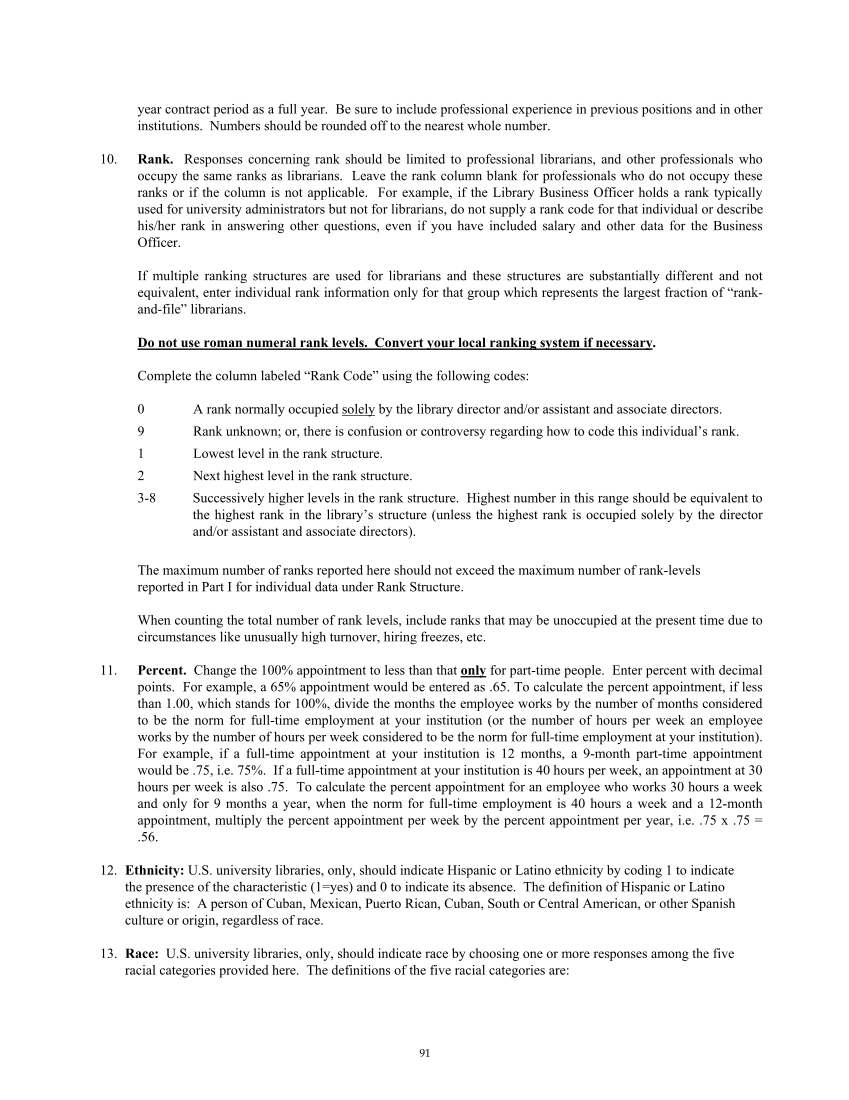91 year contract period as a full year. Be sure to include professional experience in previous positions and in other institutions. Numbers should be rounded off to the nearest whole number. 10. Rank. Responses concerning rank should be limited to professional librarians, and other professionals who occupy the same ranks as librarians. Leave the rank column blank for professionals who do not occupy these ranks or if the column is not applicable. For example, if the Library Business Officer holds a rank typically used for university administrators but not for librarians, do not supply a rank code for that individual or describe his/her rank in answering other questions, even if you have included salary and other data for the Business Officer. If multiple ranking structures are used for librarians and these structures are substantially different and not equivalent, enter individual rank information only for that group which represents the largest fraction of “rank- and-file” librarians. Do not use roman numeral rank levels. Convert your local ranking system if necessary. Complete the column labeled “Rank Code” using the following codes: 0 A rank normally occupied solely by the library director and/or assistant and associate directors. 9 Rank unknown or, there is confusion or controversy regarding how to code this individual’s rank. 1 Lowest level in the rank structure. 2 Next highest level in the rank structure. 3-8 Successively higher levels in the rank structure. Highest number in this range should be equivalent to the highest rank in the library’s structure (unless the highest rank is occupied solely by the director and/or assistant and associate directors). The maximum number of ranks reported here should not exceed the maximum number of rank-levels reported in Part I for individual data under Rank Structure. When counting the total number of rank levels, include ranks that may be unoccupied at the present time due to circumstances like unusually high turnover, hiring freezes, etc. 11. Percent. Change the 100% appointment to less than that only for part-time people. Enter percent with decimal points. For example, a 65% appointment would be entered as .65. To calculate the percent appointment, if less than 1.00, which stands for 100%, divide the months the employee works by the number of months considered to be the norm for full-time employment at your institution (or the number of hours per week an employee works by the number of hours per week considered to be the norm for full-time employment at your institution). For example, if a full-time appointment at your institution is 12 months, a 9-month part-time appointment would be .75, i.e. 75%. If a full-time appointment at your institution is 40 hours per week, an appointment at 30 hours per week is also .75. To calculate the percent appointment for an employee who works 30 hours a week and only for 9 months a year, when the norm for full-time employment is 40 hours a week and a 12-month appointment, multiply the percent appointment per week by the percent appointment per year, i.e. .75 x .75 = .56. 12. Ethnicity: U.S. university libraries, only, should indicate Hispanic or Latino ethnicity by coding 1 to indicate the presence of the characteristic (1=yes) and 0 to indicate its absence. The definition of Hispanic or Latino ethnicity is: A person of Cuban, Mexican, Puerto Rican, Cuban, South or Central American, or other Spanish culture or origin, regardless of race. 13. Race: U.S. university libraries, only, should indicate race by choosing one or more responses among the five racial categories provided here. The definitions of the five racial categories are:


















































































































